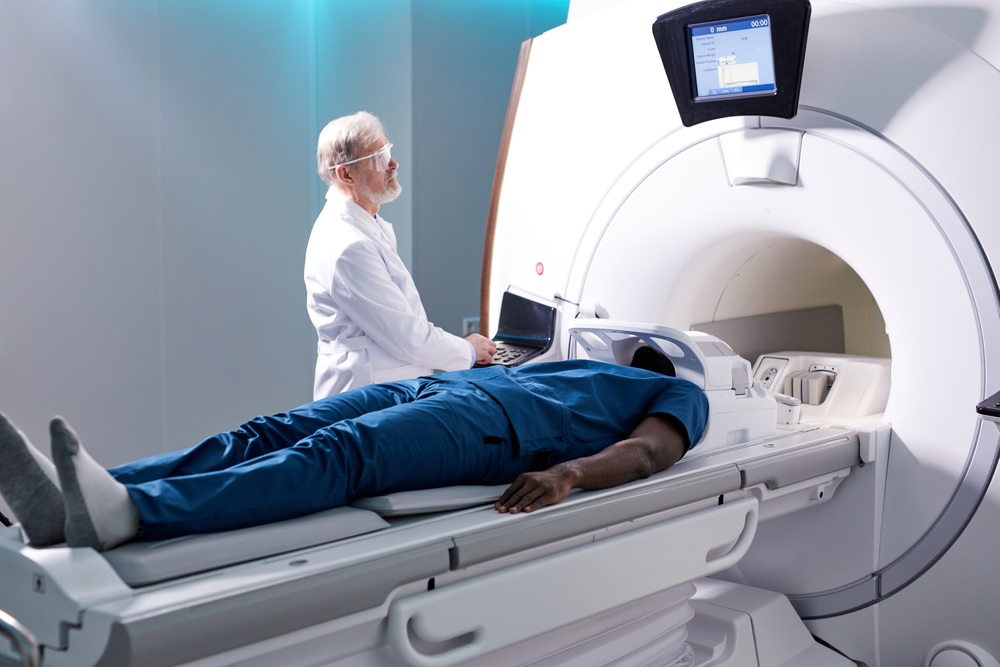Introduction1
Multiparametric MRI (mpMRI) is a sophisticated and invaluable tool in modern medical imaging. This advanced technique integrates various MRI sequences to capture multiple facets of tissue characteristics. These sequences are T1-weighted, T2-weighted, diffusion-weighted, and dynamic contrast-enhanced imaging. By skillfully combining these sequences, mpMRI generates a wealth of data, affording clinicians and researchers a more precise and comprehensive assessment of the region of interest.
Diverse Applications of mpMRI in Different Areas
MpMRI finds applications across diverse medical domains, revolutionizing diagnosis and treatment planning. Below, we explore its key applications in three critical areas of medicine:
Oncology2
MpMRI has become a pivotal diagnostic tool in oncology. It is crucial in identifying and localizing cancers, such as Prostate Cancer. It has become the gold standard for prostate cancer diagnosis, offering the ability to pinpoint suspicious areas within the prostate gland. This capability aids in targeted biopsies and facilitates precise treatment planning. Additionally, mpMRI is increasingly employed in diagnosing breast cancer, providing essential information for breast cancer staging and monitoring.

Related Case: The Impact of Over-utilization of mpMRI on Prostate Cancer Treatment2
mpMRI is becoming increasingly common in prostate cancer care. However, a recent study suggests its frequent use might result in overtreatment, particularly for patients with a higher risk of non-cancer mortality ten years after diagnosis.
The study examined the role of biomarkers, including mpMRI and genomic testing, in shaping prostate cancer treatment patterns. While these biomarkers provide insight into the disease’s biology, they often overlook patient physiology, a crucial factor in determining treatment decisions.
The non-cancer-specific mortality risk at the 10-year mark was calculated for each patient. Practices were divided into three categories based on mpMRI and genomic testing: never, below the median, or above the median. The results showed that methods with high mpMRI usage were more likely to treat patients with over a 75% risk of non-prostate cancer mortality compared to those not using mpMRI. However, for patients with under a 25% risk of non-cancer mortality, mpMRI usage did not significantly affect treatment decisions. Similarly, practices with low genomic testing usage were more likely to treat high-risk non-prostate cancer mortality patients. In contrast, genomic testing had little impact on those with a lower non-cancer mortality risk.
Neurology3
In the field of neurology, mpMRI assumes a crucial role in the study of brain structure and function. It aids in detecting and characterizing lesions, such as tumors, multiple sclerosis plaques, and vascular abnormalities. Functional MRI (fMRI), a subset of mpMRI, enables researchers to map brain activity, contributing to our understanding of cognitive functions and neurological disorders.

Related case: Advancing Glioblastoma Treatment3
Glioblastoma, a formidable form of brain cancer, presents significant challenges in treatment due to its aggressive nature and resistance to conventional therapies. In the quest for more effective treatments, a groundbreaking study utilizing mpMRI has emerged, offering insights into the response of recurrent glioblastoma to MDNA55, an interleukin-4 receptor-targeted immunotherapy.
Glioblastoma multiforme, often called glioblastoma, is one of the most aggressive and relentless brain tumors. Its ability to invade healthy brain tissue, rapid growth, and resistance to treatment have made it notoriously difficult to manage. Recurrent glioblastoma, in particular, poses a formidable challenge, as traditional therapies often prove less effective upon disease recurrence.
MDNA55, an immunotherapy that targets the interleukin-4 receptor (IL-4R), offers a promising avenue for glioblastoma treatment. By specifically targeting IL-4R, MDNA55 aims to disrupt the tumor’s ability to grow and evade the immune system, potentially providing a more targeted and effective approach to treatment.
The study in question leveraged the power of mpMRI to assess the response of recurrent glioblastoma patients to MDNA55 immunotherapy. MpMRI combines various MRI sequences, providing comprehensive data on tumor characteristics and response to treatment. It has proven invaluable in the realm of brain tumor evaluation.
Key Insights from the Study3
1. Tumor Response Evaluation: MpMRI allowed researchers to monitor changes in glioblastoma lesions following MDNA55 treatment closely. They gained a holistic view of tumor response by analyzing multiple parameters such as contrast enhancement, diffusion, perfusion, and spectroscopy.
2. Treatment Effectiveness: The study unveiled crucial insights into the effectiveness of MDNA55 immunotherapy. Researchers could identify whether the treatment-induced changes in tumor vascularity, cellularity, or metabolic activity are pivotal in evaluating treatment response.
3. Personalized Medicine: MpMRI’s ability to provide detailed information on individual patient responses to MDNA55 offers the potential for personalized treatment plans. Tailoring therapy based on real-time imaging data could optimize outcomes and minimize adverse effects.
Cardiovascular Imaging4
MpMRI extends its capabilities to cardiology, offering detailed images of the heart. This enables the assessment of cardiac function, the identification of abnormalities, and the evaluation of blood flow. It is pivotal in diagnosing conditions like heart disease and congenital heart defects.

Related case: Revealing Loeffler’s Endocarditis with Multiparametric Cardiac MRI4
Loeffler’s endocarditis belongs to a group of rare heart disorders characterized by eosinophilic infiltration of the endocardium—the inner lining of the heart chambers. This condition can lead to various cardiac issues, including restrictive cardiomyopathy, heart failure, and thromboembolic events. Its elusive nature often makes diagnosis a formidable challenge.
Key Insights from the Study4
1. Visualizing Cardiac Tissue: Multiparametric CMR allowed the researchers to visualize the heart’s tissue composition in remarkable detail. They could assess the presence and extent of fibrosis and inflammation—a critical aspect of diagnosing Loeffler’s endocarditis.
2. Functional Assessment: The study delved into the heart’s functionality. Researchers could evaluate cardiac chamber size, wall thickness, and ejection fraction. This information offered insights into how the heart coped with the disease’s impact.
3. Detecting Cardiac Thrombi: Loeffler’s endocarditis often presents a risk of thromboembolic events. Multiparametric CMR provides a window into the heart’s chambers, enabling the detection of potential cardiac thrombi—a vital aspect of patient management.
Advantages and Future Aspects
The primary advantage of mpMRI is its ability to capture multiple parameters simultaneously, reducing the need for various scans and invasive procedures. This not only improves patient comfort but also enhances diagnostic accuracy. As technology advances, mpMRI will likely find broader applications across various medical fields. Its non-invasive nature and ability to provide comprehensive data make it an invaluable tool for early diagnosis, treatment planning, and monitoring of different medical conditions. In conclusion, multiparametric MRI is a game-changer in medical imaging. Its ability to provide a multi-faceted view of tissues and organs has revolutionized how we diagnose and manage diseases. With ongoing research and development, we can expect mpMRI to continue making significant contributions to healthcare in the years to come.1,2,3,4
References
- What is multiparametric MRI? [Internet]. University Hospitals of Derby and Burton NHS. Available from: https://www.uhdb.nhs.uk/afirm-study-multiparametric-mri/#:~:text=Combining%20several%20different%20MRI%20techniques
- High use of mpMRI associated with overtreatment of patients with prostate cancer [Internet]. Urology Times. 2023 [cited 2023 Oct 3]. Available from: https://www.urologytimes.com/view/high-use-of-mpmri-may-be-associated-with-overtreatment-of-patients-with-prostate-cancer
- Mohan S, Wang S, Chawla S, et al. Multiparametric MRI assessment of response to convection-enhanced intratumoral delivery of MDNA55, an interleukin-4 receptor targeted immunotherapy, for recurrent glioblastoma. Surgical Neurology International. 2021 Jul 6;12:337.
- Gastl M, Behm P, Jacoby C, et al. Multiparametric cardiac magnetic resonance imaging (CMR) for the diagnosis of Loeffler’s endocarditis: a case report. BMC Cardiovascular Disorders. 2017 Mar 11;17(1).



